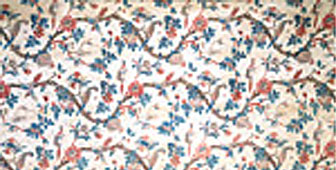Cotton weaves rich, colourful Swiss history

The Swiss role in the development of the textile industry is one of the surprising parts of an exhibition in Geneva on the history of cotton.
From a Givenchy dress to ancient Mayan cloths and American patchwork quilts, cotton, it seems, has left an important artistic and social thread running through the ages. The exhibition, “Cotton: the Exoticism and Luxury of an Everyday Fibre”, contains 150 pieces tracing the history of this versatile fabric.
Cotton’s short fibres make it harder to spin than flax, but easier to dye. Because of its flatter and denser texture, it is also easier to print on it. And when printed, it can also be washed. It is not difficult to understand how it came to be used in both everyday clothes and luxury garments.
The cotton plant originated in India and Latin America – cotton fabric dating back to 3000 BC has been found in the Indus Valley, while pre-Columbian civilisations were using cotton in Mexico 500 years before the birth of Christ.
Amazing the Europeans
The beautifully ornate Indian fabrics helped the spread of cotton to Persia, the Arab world and eventually Europe. Indeed, the word cotton comes from the Arabic “al-qutn”.
Even if Italian – and Swiss – workshops were weaving cotton by the 12th and 13th Centuries, the fibre was virtually unknown in Europe before the 17th Century, when the East Indies trading companies created by the European powers began importing Indian textiles.
“Europeans were really amazed when they first saw these printed fabrics,” says museum restorer Alexandre Fiette, pointing at a 17th century Palempore – an Indian wall hanging, with a typical design of a tree, exotic animals and a border.
“There was nothing like this in Europe – and no way of achieving anything like it. It was totally new,” he told swissinfo. Before cotton, printed materials could not be washed.
Fiette explains how, to begin with, the finished fabrics were imported. Later, the Europeans found out how they were made, copied the techniques and created the textile industry we now know.
“It made fashion accessible to ordinary people for the first time,” he says.
Demand for these fabrics was enormous, but it was not only the cotton mills of northern England that satisfied it. In the mid- to late 18th Century, Switzerland was the most important textile-producing centre in continental Europe.
Calico industry
Cotton had been woven in Basel as early as 1380, and in Zurich from the start of the 15th Century. But it was Geneva, not yet then part of Switzerland, that became one of the principal gateways into Europe for raw and spun cotton, as well as finished Indian and Persian fabrics. Its first calico factory began work at the end of the 17th Century.
The city’s success was in part due to the decision by King Louis XIV of France to ban the importation and production of decorated fabrics, save for those made by the French East India Company. This created a booming contraband market that the Swiss happily exploited
Geneva’s position was strengthened further by the arrival of some 20,000 French protestant refugees – the Huguenots — many of them skilled textile-makers, who fled persecution after Louis revoked the Edict of Nantes.
Golden age
Some, like Daniel Vasserot, became the leading calico manufacturers in Switzerland. By 1720, Geneva had seven such factories. From the middle of the 18th Century, this lucrative industry spread to other parts of Switzerland – first Neuchatel and Basel, then Biel and Berne, and eventually every region.
The golden age of industrialised Swiss calico production was the end of the 18th Century, when, it is estimated, a quarter of the population relied directly or indirectly on the cotton industry.
But an increase in import duties on foreign fabrics in France and other European countries spelt the beginning of the end for the Swiss calico industry.
Only the production of handkerchiefs in canton Glarus in the 19th Century – examples of which are in the exhibition – seemed to buck this trend.
The exhibition runs until April 7.
by Roy Probert

In compliance with the JTI standards
More: SWI swissinfo.ch certified by the Journalism Trust Initiative









You can find an overview of ongoing debates with our journalists here . Please join us!
If you want to start a conversation about a topic raised in this article or want to report factual errors, email us at english@swissinfo.ch.